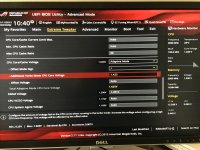SVID if you have it enabled changes how much voltage your chip asks for based on the VID table. It modifies how aggressively the cpu requests voltage from the VRM. If you have a static voltage set, i.e. manual, it's not supposed to be active. LLC will interact with a static Vcore to overvolt. It's when Adaptive is set that they come into play. Likewise with adaptive 'IA AC and DC load lines' and LLC can interact to overvolt, so don't leave them on Auto.
-----------------
btw, Adaptive is the preferable Vcore setting to use. Enabled it allows the Vcore to step down the VID table with frequency. I know a lot of OC'ers avoid it, but it helps with temps and power. Also has less Vdroop. And of course the cpu isn't sat at high voltage when idling.
With Adaptive you'll need your stable voltage on load from testing. Set that by using the offset, look at the Vcore from the VID at offset=0. Then add or remove to adjust it. SVID using 'worst case' will request more voltage by default for a given frequency, so uses a smaller offset. 'Best case', the cpu will request a lower voltage (VID) for a given frequency and needs a bigger offset.
Does that help? I know it can all be a bit confusing to start.
 i had a monoblock i wanted to use so i was a bit stuck with upgrade choices but I managed to return that as well.
i had a monoblock i wanted to use so i was a bit stuck with upgrade choices but I managed to return that as well. 


